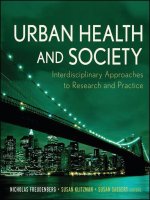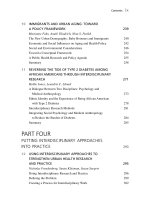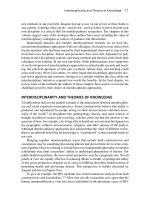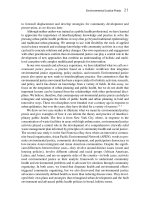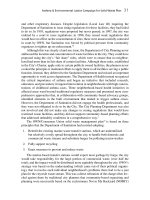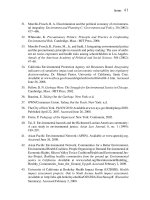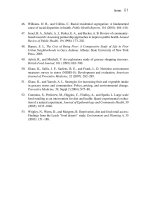Urban Health and Society: Interdisciplinary Approaches to Research and Practice - Part 25 ppsx
Bạn đang xem bản rút gọn của tài liệu. Xem và tải ngay bản đầy đủ của tài liệu tại đây (70 KB, 10 trang )
Social and Economic Determinants of Health After Disasters 221
Historical processes also infl uence the postdisaster outcome, particularly as related
to historical - political relationships. As Olsen and colleagues
22
point out, many of the
most disaster prone countries worldwide are in areas that are of little security interest
to the United States or other developed countries and therefore receive minimal emer-
gency funding. Colonial historical relations also infl uence responses and therefore
postdisaster consequences. In an interesting recent example, the 7.5 magnitude earth-
quake that hit Mozambique in February 2006 was notably benign in part due to
building codes imposed on the country by Portugal during the colonial period.
23
Political structures and systems of governance establish the parameters (e.g., taxation,
federal - state relations) that shape many of the other contextual factors infl uencing
health after disasters. For example, analyses of state failures such as those that have
occurred in Liberia and Somalia and which often precede or predispose to disasters
show that these events are far more likely to occur in partial as compared to fully dem-
ocratic regimes.
24
Similarly, postdisaster response may be infl uenced by political
structures and governance, as we describe in more detail later.
Even within areas that share geographic, historical, and political structures, the level
of community wealth acts as a local vulnerability or a capacity. There is an abundance of
research in public health demonstrating that aggregate community socioeconomic status
is associated with health, independent of individual socioeconomic position. Community
socioeconomic status encompasses multiple domains, including high rates of poverty
and unemployment and lower education and income levels.
25
Empirically, low commu-
nity socioecological status (frequently also referred to as community deprivation) is a
determinant of health outcomes, including health - related behaviors, mental health, infant
mortality rate, adult physical health, coronary heart disease, and mortality even after
accounting for individual - level factors.
26
Low community socioeconomic status may
affect residents ’ health through two primary mechanisms: (a) by limiting the availability
of salutary resources that may be benefi cial to residents ’ well - being and (b) through psy-
chosocial stress accompanying a chronic shortage of essential resources.
27
These social
mechanisms also explain how community socioeconomic status may infl uence health in
the disaster context. After disasters, when both formal and informal resources are lim-
ited, societies with a priori fewer resources are less likely to have access to salutary
resources such as health and social services or food reserves. Consistent with this line of
reasoning, Norris et al.
28
showed that individuals who lived in developing countries and
presumably had fewer protective resources were at far greater risk of experiencing poor
health outcomes in the postdisaster setting than those living in the United States. They
report in their meta - analysis that 78 percent of the samples from developing countries
showed signs of postdisaster impairment compared with 25 percent of the samples from
the United States.
The physical environment is perhaps one of the most obviously central features of
context to postdisaster recovery. Structures like buildings, bridges, and other infrastruc-
ture may be vulnerable to natural or human - made disasters and may directly infl uence
the postdisaster context and the severity of the disaster consequences. For example,
c09.indd 221c09.indd 221 6/3/09 12:04:50 PM6/3/09 12:04:50 PM
222 Population Health After Disasters
features of the physical environment can be immediately linked to fatality rate after
disasters as seen in the recent earthquakes of comparable magnitude in Kobe, Japan, in
1995 and Bam, Iran, in 2003 that were associated with 5,200 and 26,000 deaths,
respectively.
21
,
29
Much of this difference was attributed to the different quality of build-
ings; Japanese buildings had been reinforced to cope with earthquake tremors, but
much of the Iranian city of Bam collapsed with the earthquake, killing thousands of
residents.
30
Clearly, given that more than half of the global population is or very soon
will be living in urban settings, this has important consequences for health and well -
being in postdisaster settings.
28
This rapid urbanization creates tremendous challenges
in part because many urban dwellers will be living in slums, which are likely loci of
multiple physical vulnerabilities.
31
Culture, which coexists with these elements, is likely to be an important element
structuring postdisaster outcomes. Culture, defi ned as beliefs or rules of behavior that
are passed on from one individual to another by some form of social learning,
32
may
infl uence individual and community responses to disasters as well as the health conse-
quences thereafter, such as health - seeking behavior, mental health experiences, and
the provision of resources by dominant groups. Because members of groups often, by
defi nition, share norms and beliefs, groups of people will likely experience, react, and
respond in very different ways to the same disaster event. Among this set of beliefs,
some researchers have suggested that differing and culturally specifi c norms related to
fatalism may alter both pre - and postdisaster responses.
33
Some evidence to support
this claim has been shown through interviews with survivors of Hurricane Andrew.
There is also the possibility that expressions of posttraumatic stress disorder and other
mental health morbidity may vary by ethnic or cultural group.
34
Despite culture’s
seemingly important role, few studies analyze the role of culture in the postdisaster
milieu. These limitations refl ect, in part, a lack of ethnography used in the immediate
postdisaster context
35
and diffi culties in measuring shared norms and beliefs.
Additionally, cooperation and the capacity to mobilize or create informal political or
social groups may be a critical resource in the postdisaster situation. For instance, in
rural Tanzania, a local vigilante group was instrumental in enforcing a ban on intervil-
lage trading to reduce the spread of cholera, and in another situation, they successfully
cooperated to defend a large amount of rice left roadside after a rice - bearing truck
crashed (B. Paciotti, personal communication, April 14, 2006). Such widespread coop-
eration, which varies quite dramatically between cultures and groups,
36
,
37
could have a
substantial impact in the postdisaster setting where many other salutary resources are
limited.
The complexity of the determinants of population health after disasters suggests it is
unlikely that any single disciplinary perspective or framework will afford us the tools to
fully understand how the determinants of population health interrelate to shape the health
of populations. An interdisciplinary approach that simultaneously capitalizes on epide-
miological rigor and anthropology ’ s “ radically contextualizing ” roots has the potential to
draw on quantitative and qualitative methods that can be complementary and help us
to understand the etiology of the health consequences of these events. For example, the
c09.indd 222c09.indd 222 6/3/09 12:04:50 PM6/3/09 12:04:50 PM
Humanitarian Crises in Angola and the Balkans 223
social autopsy approach, which integrates multiple levels of causation, was used to
explore the underlying causes of differential health outcomes following the Chicago heat
wave. This approach could begin to assess whether vulnerabilities and capacities act in
isolation or interact at the individual and community levels with cultural, socioeconomic,
and global political and historical forces to produce specifi c health outcomes after a
disaster. Thus, the epidemiologic focus on categorical health outcomes can be augmented
by historical and ethnographic data that can link the consequences of disasters to declin-
ing tax revenues, poor and myopic government planning, racial discrimination, and high
rates of individual - and community - level poverty.
We use here three relatively recent disasters as case studies to illustrate the roles
of vulnerabilities and capacities acting and interacting across multiple levels as well as
the value of adopting a historical, cross - cultural, social science perspective. First, we
examine the social determinants in infl uencing health and well - being in two similar
crises resulting from political rather than environmental events. Next, we explore the
social determinants of outcomes following Hurricane Katrina and the events of
September 11, 2001. In each case, we draw on various data sources to highlight under-
lying vulnerabilities and capacities and attempt to show how these infl uences produce
and reproduce differential outcomes within and between populations.
HUMANITARIAN CRISES IN ANGOLA AND THE BALKANS
In the postconfl ict periods following the political crises in Angola
38
and the Balkans,
39
,
40
health outcomes varied markedly between these two countries. In both cases, political
instability led to large - scale population displacement and social unrest, and the displaced
peoples were almost entirely reliant on food assistance. Despite these similarities, the
prevalence of undernutrition in the Kosovar population (one of the many ethnic groups
within the Balkans) remained at approximately 2 percent throughout the crisis, whereas
the prevalence of undernutrition in Angola increased throughout the crisis from 2.3
percent to 15 to 21 percent. Why did the prevalence of undernutrition increase by nearly
tenfold in the Angola case, whereas there was no detectable increase in the levels of
undernutrition in the Balkans? In both cases, large numbers of people were affected by
violent political instability that brought about disastrous consequences for the provision
of government and social services, and both resulted in substantial opportunity costs.
To the wage earner in the Balkans, the disaster brought with it lost wages. To the farmer
in Angola, the disaster brought unplanted crops or harvests consumed by rebel forces or
internally displaced people.
40
At least three key differences in population vulnerabilities and capacities emerge,
which likely account for the vastly different health consequences observed in these
humanitarian disasters. In the case of Angola, humanitarian aid was in short supply.
The UN ’ s 2002 calls for humanitarian assistance repeatedly fell short of their mark,
with only 30 percent of the appeal being funded during critical periods of the crisis.
41
,
42
One report expressed surprise and dismay, noting that “ it is alarming . . . that the UN
Consolidated Inter - Agency Appeal (CAP) has so far met with a very poor response
c09.indd 223c09.indd 223 6/3/09 12:04:50 PM6/3/09 12:04:50 PM
224 Population Health After Disasters
from the international donor community, despite the emergency having been branded
as the worst crisis in the world at present. ”
43
Emergency aid that did appear often was
unable to be effi ciently transferred to those most in need, in large part because of the
large number of land mines placed by the opposition UNITA forces. In the Balkans,
international aid agencies were able to take preemptive action and to reach locations,
and thus continue to deliver vital aid in the postcrisis period. The UN assessment was
that “ overall, the international community has been successful in preventing acute
[nutritional] wasting, among the Kosovan refugees. ”
44
At the community and individual level, these two populations differed consider-
ably in overall wealth. In the Balkans, which lacked the extreme poverty found in
Angola, this enabled wealth redistribution and therefore acted as a population - level
capacity, whereas in Angola low levels of wealth disallowed redistribution, and social
networks were powerless to assist those in need. Further, household food insecurity
assessments identifi ed critical shortfalls in food in Angola, but this was not necessarily
the case in the Balkans. Subsequent assessment showed that a large number of Albanian
households (another ethnic group within the Balkans) had family members living either
abroad or outside the confl ict area who were sending remittances that were critical for
protecting households from food insecurity.
40
Yet, in the Angola case, because few
households had family living outside the confl ict area, few people received remittances,
and lacking such safety nets, shocks to the households were not successfully buffered.
These patterns suggest that variation in health outcomes in the postdisaster period are
linked to global variation in international aid and perhaps to global migration patterns,
which enable individuals to relocate and send remittances, thereby diminishing the neg-
ative impact of decline in social services during a confl ict period.
To put this in the context of our conceptual model, privileged political positions
and global migration patterns are likely underlying capacities to the extent that they
facilitate emergency aid donations and the ability of individuals to redistribute resources
through remittances. This later point may be particularly salient in light of the rapidly
urbanizing global community and the hypothesized reduction in informal safety nets
that are expected to accompany this shift. Some have hypothesized that formal safety
networks will emerge to take over the functions of informal safety nets, but the avail-
able evidence from sub - Saharan Africa does not support any clear urban bias in the
availability of formal safety nets.
45
As in the Angola example, urbanization may be asso-
ciated with limited formal and informal safety nets, which in the post - postdisaster
setting erodes health and well - being. Preexisting health conditions, in this case under-
nutrition, also contribute to a reduced capacity to effectively respond in the context of
markedly increased stress. Thus, these cases illustrate how during and after a disaster,
individual, community, and global forces interact to position populations along distinct
tracks that lead some to stable or improved health and others to poor health outcomes.
HURRICANE KATRINA
Hurricane Katrina was a category 3 hurricane when it hit the Gulf Coast of the United
States on August 29, 2005. Despite suffi cient warning and offi cials at all levels being
c09.indd 224c09.indd 224 6/3/09 12:04:51 PM6/3/09 12:04:51 PM
Hurricane Katrina 225
“ acutely aware of Katrina and the risk it posed, ” the storm contributed to more than
1,800 deaths, billions of dollars of damage, and the displacement of between 700,000
and 1.2 million people.
46
Austin
47
provides an excellent overview that mixes historical
reports with current ethnography to illustrate how power, resources, and geography
created vulnerabilities in the region even before Hurricane Katrina hit. In addition to
the preexisting geographic and power vulnerabilities, socioeconomic vulnerabilities
already existed at both the state and individual level; the three states (Louisiana,
Alabama, and Mississippi) that bore the burden of the storm were among the poorest
in the United States,
48
a fact that has implications for the citizenry and the level of
support available in crisis situations. Groups with preexisting vulnerabilities were
predicted to be differentially affected by the storm, and media coverage and preliminary
reports suggested poverty and race were key predictors of risk of damage to material
and physical resources.
Two separate reports confi rm this general assessment but offer a more nuanced
perspective.
46
,
49
An examination of census tract data reveals that the overall population
living in areas considered damaged by Federal Emergency Management Agency
(FEMA) criteria were disproportionably black (45.7 percent vs. 26 percent black in
nondamaged areas). Damaged areas also had a higher proportion of individuals living
in rental homes (45.7 percent vs. 30 percent in nondamaged areas) and greater per-
centages of people living below the poverty line (20.9 percent vs. 15.3 percent in
nondamaged areas) and who were unemployed (7.6 percent vs. 6.0 percent in nondam-
aged areas). Death reports also show that elderly white individuals were at the highest
risk of death. To be sure, there were also areas with considerable damage that dispro-
portionally comprised individuals who were white and wealthy, yet the statistical
patterns reveal deep social divides. These patterns of differential impact have signifi -
cant implications for current and future health consequences.
50
More than 500,000
people are estimated to have an unmet need for mental health services when the num-
ber of medical professionals is near its nadir. In addition to the health impact of
depression and other common mental disorders, depression is associated with hyper-
tension, heart disease, and diabetes. Mental health outcomes are also expected to give
rise to increased rates of substance use and abuse. Further, consistent with our model,
the impact of these health outcomes is unlikely to fall equally on all. Some evidence,
for instance, suggests that African Americans are less likely than other racial/ethnic
groups to seek care for mental health morbidities such as posttraumatic stress disorder
following disasters.
51
Higher rates of poverty and lower rates of health insurance,
which will be amplifi ed by the reduced availability of social services, may also under-
cut attempts to rebuild physical and mental health and economic well - being.
52
Hurricane Katrina therefore exacerbated preexisting vulnerabilities. Although in
many cases effective governance or formal safety networks can act as population - level
capacities and serve to attenuate, protect, or eliminate negative health effects experi-
enced as a result of population - level vulnerabilities, this was largely not the case with
Hurricane Katrina. In the case of Katrina, the governmental response was described as
“ uncoordinated ” and “ hampered by ineptitude, lack of leadership and bureaucratic turf
wars across all levels of government. ”
53
Consequently, despite being warned that the
c09.indd 225c09.indd 225 6/3/09 12:04:51 PM6/3/09 12:04:51 PM
226 Population Health After Disasters
storm would be disastrous, the governmental response lagged, and the primary res-
ponse did not occur until two days after Katrina landfall.
54
Part of this delay was due to
confusion at multiple levels within the government. Local governments believed that
the federal government would take primary responsibility and the lead, but the federal
government believed that in disaster situations, “ the role of the federal government is
not and should not ever be that of a fi rst responder. ”
54
Rather, FEMA believed “ states
have the primary responsibility for emergency preparedness and response in their
jurisdictions, ”
54
although planning exercises simulating a disaster of this magnitude
led to the conclusion that an event of the magnitude of Katrina would require fi rst - line
federal response.
Others noted that FEMA was unable to actually carry out its job because of changes
in the department ’ s structure, and increasing amounts of energy focused on being prepa-
red to deal with terrorist strikes. Part of the poor response also appears to have stemmed
from a limited appraisal of how other similar humanitarian crises have unfolded in the
other parts of the world, representing a Western - centric public health model. Thus,
despite an awareness that large numbers of individuals would be evacuated (this assump-
tion was built into simulation exercises), governmental responses seemed to contain
little information on how to handle mass displacement of the population. There is a
voluminous literature from foreign refugee crises that would have been helpful in plan-
ning such a response.
55
Nieburg et al. point out that one of the primary lessons from such
foreign refugee crises is to have suffi cient water and appropriate food on hand to feed
large numbers of displaced individuals; this is a lesson that was apparently not learned
on several prior occasions in which the Superdome was used as a shelter.
56
Although in this case the formal response was delayed, informal safety nets
quickly emerged. The notion that postdisaster behavior is marked by widespread devi-
ance, including looting, panic, and extreme psychological dysfunction, is referred to
as the disaster myth.
57
In contrast to the disaster myth, empirical research on popula-
tion behavior in the postdisaster setting rarely conforms to that predicted by the disaster
myth model. Rather, behavior is often highly prosocial, calm, and rational. In his
ethnographic account of helping behavior during Katrina, Ethridge
58
describes the
emergence of “ leaderless ” prosocial behavior in a group of individuals temporarily
occupying a high school. Group consensus emerged over a range of behaviors and
tasks, and many norms temporarily fell by the wayside. For instance, age hierarchies
broke down, and youth played a critical role in fetching supplies, in part because older
individuals were incapacitated by infections on their extremities (due to limited facili-
ties for bathing). Again, this case study documents how multiple lines of evidence
reveal multiple layers of vulnerabilities and capacities that interact to amplify the dele-
terious impact of disasters on vulnerable populations.
SEPTEMBER 11, 2001, TERRORIST ATTACKS ON NEW YORK CITY
The New York City (NYC) metropolitan area is the largest and most densely popu-
lated metropolitan area in the United States.
48
Although estimates of population size
c09.indd 226c09.indd 226 6/3/09 12:04:51 PM6/3/09 12:04:51 PM
September 11, 2001, Terrorist Attacks on New York City 227
vary depending on the areas selected as boundaries of the metropolitan area, approxi-
mately 15 million people live in the vicinity of NYC in the tristate area of New York
State, New Jersey, and Connecticut. Perhaps as a result of the preeminent role played
by NYC in national discourse, the attacks on the World Trade Center (WTC) were per-
ceived as an attack on the United States. The attacks themselves started on 8:46 a.m.
on the morning of September 11, 2001, and consisted of two hijacked airplanes hitting
the WTC towers, which eventually collapsed. Two other airplanes were also hijacked
that day with one crashing into the Pentagon and the other into a fi eld in Pennsylvania.
During the day of September 11, “ fog of war ” rumors had many in the NYC metropoli-
tan area afraid for their lives. Early rumors of more planes being hijacked and aimed
for other NYC and national targets were rife. As round - the - clock, real - time television
coverage of the attacks saturated the airwaves, millions in the area saw images fi rst of
people waving for help from the towers of the WTC and then of the towers falling.
Meanwhile, countless residents of the tristate area knew someone or were related to
someone who was working in the WTC. Disrupted communications systems meant
that many were uncertain about the fate of family or friends for most of the day of
September 11 and, in many cases, for days after the attacks.
In many respects, the aftermath of the terrorist attacks on New York City repre-
sented a model of community mobilization in response to a mass trauma. There was a
highly visible and mostly effective mobilization of municipal and national resources to
aid those affected by the attacks and a rapid engagement of resources to assist the pop-
ulation of the area both in the short term and in the relative long term. Approximately
$ 20 billion in federal aid was routed to New York City in the aftermath of the attacks.
59
For example, Project Liberty was a free service established to provide counseling after
the attacks.
60
It was established soon after the September 11 attacks and was fully func-
tional until 2004, at which point several of the services it provided were reduced. All
services were terminated in 2005. During its existence, Project Liberty provided ser-
vices to approximately 750,000 persons in the NYC metropolitan area.
61
It made as a
core part of its mission specifi c outreach efforts aimed at ensuring that all residents of
New York City would avail themselves of services if needed. However, despite the out-
pouring of national attention after the attacks and the relatively effective functioning of
offi cial governmental resources in the aftermath of the attacks (particularly when com-
pared with the response after Hurricane Katrina, as discussed earlier), the health
consequences of the September 11, 2001, terrorist attacks clearly refl ected underlying
vulnerabilities that were largely predicated on socioeconomic circumstance.
Several studies have amply documented that the psychological and behavioral
consequences of the September 11, 2001, terrorist attacks extended well beyond those
who are typically considered victims of such disasters and into the general popula-
tion.
35
,
62
–
65
Persons who were more exposed to the disaster (e.g., persons who lived
closer to the WTC complex, persons who had a friend or relative killed in the attacks)
were more likely to have psychological symptoms and adverse health behavior than were
those who were not directly exposed to the disaster. Overall, it has been estimated that
persons directly affected by the attacks were 3.5 times more likely to have adverse mental
c09.indd 227c09.indd 227 6/3/09 12:04:51 PM6/3/09 12:04:51 PM
228 Population Health After Disasters
health symptoms after the attacks than persons who were not directly affected.
66
However,
once direct and immediate exposure to the attacks is taken into consideration, the exten-
sion of the consequences of these attacks to the general population provides several
examples of the role of social vulnerabilities and capacities in shaping health after this
disaster.
One of the more consistent observations that emerged from research carried out
after the September 11, 2001 terrorist attack was the differential risk of psychopathol-
ogy among different ethnic groups. Several studies showed that Hispanics had a
higher prevalence of psychopathology than did other racial/ethnic groups
63
,
67
and
specifi c analyses showed that Hispanics of Dominican or Puerto Rican origin were
more likely than other Hispanics and non - Hispanics to report symptoms consistent
with posttraumatic stress disorder (PTSD) after the September 11 terrorist attacks.
63
In one study that attempted to understand the reason behind these differences, it was
shown that Dominicans and Puerto Ricans were more likely than persons of other
races/ ethnicities to have lower incomes, to be younger, to have lower social support,
to have had greater exposure to the September 11 attacks, and to have experienced an
emotional reaction upon hearing of the September 11 attacks. These variables accoun-
ted for 60 to 74 percent of the observed higher prevalence of probable PTSD in these
groups.
63
The role of pre - and postdisaster income as determinants of postdisaster function-
ing and well - being was reinforced in other analyses after this event. For example, one
analysis that focused on the longitudinal risk of PTSD after the September 11, 2001,
attacks found that unemployment at any time after the attacks predicted PTSD persis-
tence even when accounting for a range of other potentially confounding covariates. In
addition, high levels of perceived work stress predicted PTSD persistence among per-
sons employed after September 11, 2001, and this was associated with poor mental
health.
68
Therefore, in the aftermath of the September 11 attacks, individual socioeco-
nomic position and job status both contributed to differences in postdisaster mental
health and may explain many of the other differences observed between racial/ethnic
groups after this event.
A further illustration of this point has been recent work that showed empirically
that properties of urban neighborhoods of residence were associated with the individ-
ual risk of psychopathology after the September 11, 2001 attack, even after accounting
for individual vulnerabilities. Specifi cally, in this postdisaster context, neighborhood -
level income inequality has been shown to be associated with depression among
persons with lower income.
69
It has been hypothesized that persons with individual
socioeconomic disadvantage may be more socially or economically marginalized and
dependent on local resources and hence more vulnerable to the consequences of this
particular disaster. Other work has shown that neighborhood poverty was associated
with the risk of incident depression in the years after the attacks even when accounting
for individual socioeconomic status.
70
Taken together, data pulled from studies on
mental health outcomes following the September 11 attacks amply demonstrate the
role of vulnerabilities and capacities and how these play out across individuals, groups,
c09.indd 228c09.indd 228 6/3/09 12:04:52 PM6/3/09 12:04:52 PM
Implications for Prevention and Intervention 229
and communities. In addition, the events of September 11, 2001 illustrate how the
uniquely urban characteristics of population density and diversity, complexity, and
income inequality, described in Chapter One of this volume, infl uenced how this disas-
ter affected health.
IMPLICATIONS FOR PREVENTION AND INTERVENTION
Underlying socioeconomic vulnerabilities — both individual and ecological —
contributed to shaping health after the September 11, 2001 attack, much as they did
after Hurricane Katrina and after the humanitarian crises in Angola and the Balkans.
These events are clearly substantially different, and the mobilization of external
resources in response to these events is dramatically different both in scope and effec-
tiveness. However, social and ecological factors consistently infl uence health and well -
being after all these events, further reinforcing the premise guiding this chapter that
underlying conditions represent a spectrum of vulnerabilities and capacities that shape
postdisaster health and functioning. In addition, postdisaster interventions, while poten-
tially helpful as protective factors, cannot obviate the role played by baseline factors in
shaping the outcomes of disasters.
Therefore, the conceptual model presented here suggests and the case studies
illustrate how the production of population health in the aftermath of disasters refl ects
a combination of underlying vulnerabilities and capacities interacting with the disaster
stressor itself and potentially mitigated by postdisaster protective factors. These case
studies also call attention to the interrelations of global - , community - , and individual -
level factors in shaping health after disasters. Our understanding of these processes is
enhanced by the use of a combination of approaches from anthropology and epidemi-
ology that consider how vulnerabilities and capacities operate in tandem and interact
across levels of units of analysis. Thus, although we can understand the causes of
morbidity and mortality outcomes in New Orleans from a biomedical or proximate
perspective, clearly the ultimate or upstream causes lie in preexisting health and eco-
nomic inequalities in the United States, in the interactions between the oil industry and
the wetlands, and in the mismanaged governmental attempts to protect citizens of the
affected areas. Similarly, we can see that appealing to family members living outside
the affected area is a critical source of support in some situations, but this capacity
is not universally shared and likely varies widely both within and between communi-
ties. The discussions of Hurricane Katrina and Angola show that, in some cases,
regardless of the existence of individual - level capacities, governmental forces can act
as barriers to action and, at worst, contribute to poor outcomes. The studies about the
September 11, 2001 attack similarly highlight the interplay among individuals, groups,
and communities. These case studies draw attention to the important role of context in
shaping postdisaster outcomes.
We suggest that there are several implications of the observations drawn here
for those concerned with public health promotion. The model of vulnerabilities and
capacities presented here strongly suggests that traditional understandings of “ disaster
c09.indd 229c09.indd 229 6/3/09 12:04:52 PM6/3/09 12:04:52 PM
230 Population Health After Disasters
preparedness ” might be substantially broadened to include elements that may have
been seen as outside the purview of disaster preparedness and even public health. The
model we propose seeks to include social inequalities, aspects of the built environ-
ment, and informal social support, for example, as key components that will infl uence
or mitigate the postdisaster environment. It might reasonably be argued that affecting
features of the social environment, such as those just mentioned, that infl uence postdi-
saster health is a challenge beyond the scope of most public health practitioners and is
certainly outside the scope of disaster preparedness. However, we believe that the
approach taken in this chapter strengthens arguments that propose structural changes
because they will pay off in general public health and in the postdisaster setting.
Further proof of this concept comes from Norris et al.
28
In their analyses, they report a
consistent fi nding across studies that individuals who were more distressed before
a disaster are likely to experience more distress after a disaster. In this chapter and
more so elsewhere,
20
we have pointed out that disaster outcomes refl ect and amplify
preexisting vulnerabilities, which strengthens the case that these determinants should
not be overlooked in the effort to mitigate disaster consequences.
There are multiple examples throughout history when public health has indeed
acted on contextual factors that expand considerably beyond the realm of individual
exposure or behavior. For example, it was public health efforts to improve sanitary
conditions in cities that led to sentinel improvements in European cities ’ infrastructure
and attendant reductions in morbidity and mortality throughout the nineteenth century.
71
Effecting structural changes requires sentinel shifts in policies that may infl uence
underlying determinants. The current increased awareness of disasters and their poten-
tial consequences creates an opportunity for advocacy and action to improve underlying
features of context that may infl uence the health of populations after disasters. Such
advocacy and action constitute a valid task for public health professionals.
If aspects of the social environment indeed infl uence postdisaster outcomes and
are amenable to intervention, then a second implication of this work is that capacities
and vulnerabilities are locally and culturally specifi c and that the relevant tools are
needed to identify these. Once identifi ed, these local assets can be leveraged to reduce
the impact of disasters through early warning systems, protect vulnerable members
of the community, and improve responses in the postdisaster period. Furthermore,
uncovering and leveraging local capacities are particularly relevant in resource - poor
settings where higher level public health services may be absent or ineffective.
Nevertheless, our understanding of these capacities and vulnerabilities is currently
biased toward already known capacities and largely based on those spelled out in the
nondisaster social epidemiological literature. We suspect that research methods such
as ethnographic and community - based participatory research designs may provide
vital insights about how individuals and communities function in the face of a disaster
and that knowledge of these local resources may be particularly fruitful in mitigating
the postdisaster response and explaining population health variation.
A fi nal implication of our ideas here is that the world ’ s population is now domi-
nated by urban dwellers. Projections estimate that by 2030, 5 billion people will be
living in urban areas throughout the world. Although urban living is associated with a
c09.indd 230c09.indd 230 6/3/09 12:04:52 PM6/3/09 12:04:52 PM

